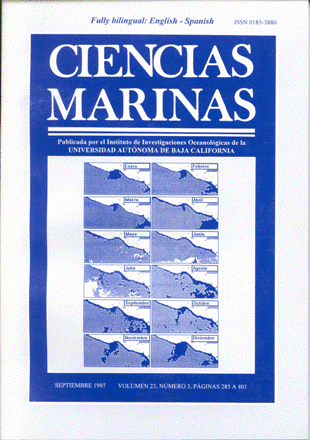The Gulf of Tehuantepec and adjacent areas: spatial and temporal variation of satellite-derived photosynthetic pigments
Main Article Content
Abstract
Photosynthetic pigment concentrations retrieved from data generated from 1978 to 1986 by the sensor Coastal Zane Color Scanner were used to describe the seasonal and interannual variation of phytoplankton biomass of the Gulf of Tehuantepec and adjacent areas. The pigment concentrations 0.3 mg m–3 and higher were considered as an index of productive waters. Its spatial coverage shows coastal upwelling in the gulfs of Tehuantepec and Papagayo (in the eastern region of the study area) between October and April. upwelling at the Costa Rica dome during summer. and the transient effect of mixing by tropical storms from July to October throughout the study area. Upwelling events in Tehuantepec and Central America are not synchronous. The region west of the Gulf of Tehuantepec is oligotrophic most of the time (less than 0.2 mg m–3). The most evident interannual variation was the effect of El Niño 1982–1983, with very low pigment concentrations associated with a deep thermocline in the whole study area. Also, there was an anti-El Niño event in 1985 in the eastern region, with high phytoplankton biomass concentrations associated with a shallow thermocline
Downloads
Article Details
This is an open access article distributed under a Creative Commons Attribution 4.0 License, which allows you to share and adapt the work, as long as you give appropriate credit to the original author(s) and the source, provide a link to the Creative Commons license, and indicate if changes were made. Figures, tables and other elements in the article are included in the article’s CC BY 4.0 license, unless otherwise indicated. The journal title is protected by copyrights and not subject to this license. Full license deed can be viewed here.

